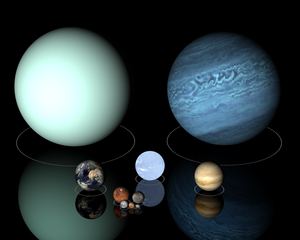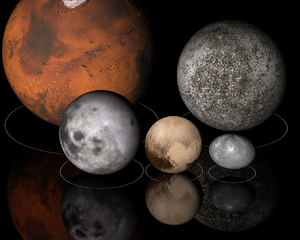Planet
From Wikipedia, the free encyclopedia
This article is about the astronomical object. For other uses, see Planet (disambiguation).
The planets were thought by Ptolemy to orbit Earth in deferent and epicycle motions. Although the idea that the planets orbited the Sun had been suggested many times, it was not until the 17th century that this view was supported by evidence from the first telescopic astronomical observations, performed by Galileo Galilei. By careful analysis of the observation data, Johannes Kepler found the planets' orbits were not circular but elliptical. As observational tools improved, astronomers saw that, like Earth, the planets rotated around tilted axes, and some shared such features as ice caps and seasons. Since the dawn of the Space Age, close observation by space probes has found that Earth and the other planets share characteristics such as volcanism, hurricanes, tectonics, and even hydrology.
Planets are generally divided into two main types: large, low-density gas giants and smaller, rocky terrestrials. Under IAU definitions, there are eight planets in the Solar System. In order of increasing distance from the Sun, they are the four terrestrials, Mercury, Venus, Earth, and Mars, then the four gas giants, Jupiter, Saturn, Uranus, and Neptune. Six of the planets are orbited by one or more natural satellites.
More than a thousand planets around other stars ("extrasolar planets" or "exoplanets") have been discovered in the Milky Way: as of 1 May 2014, 1786 known extrasolar planets in 1106 planetary systems (including 460 multiple planetary systems), ranging in size from Earth to gas giants larger than Jupiter.[3] On December 20, 2011, the Kepler Space Telescope team reported the discovery of the first Earth-sized extrasolar planets, Kepler-20e[4] and Kepler-20f,[5] orbiting a Sun-like star, Kepler-20.[6][7][8] A 2012 study, analyzing gravitational microlensing data, estimates an average of at least 1.6 bound planets for every star in the Milky Way.[9] Around one in five Sun-like[b] stars is thought to have an Earth-sized[c] planet in its habitable[d] zone.



Tidak ada komentar:
Posting Komentar